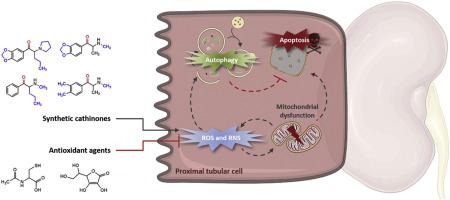当前位置:
X-MOL 学术
›
Toxicol. Lett.
›
论文详情
Our official English website, www.x-mol.net, welcomes your
feedback! (Note: you will need to create a separate account there.)
The interplay between autophagy and apoptosis mediates toxicity triggered by synthetic cathinones in human kidney cells
Toxicology Letters ( IF 2.9 ) Pub Date : 2020-10-01 , DOI: 10.1016/j.toxlet.2020.05.025 I Vaz 1 , T Carvalho 1 , M J Valente 2 , A Castro 1 , A M Araújo 3 , M L Bastos 3 , M Carvalho 4
Toxicology Letters ( IF 2.9 ) Pub Date : 2020-10-01 , DOI: 10.1016/j.toxlet.2020.05.025 I Vaz 1 , T Carvalho 1 , M J Valente 2 , A Castro 1 , A M Araújo 3 , M L Bastos 3 , M Carvalho 4
Affiliation

|
Synthetic cathinones abuse remains a serious public health problem. Kidney injury has been reported in intoxications associated with synthetic cathinones, but the molecular mechanisms involved have not been explored yet. In this study, the potential in vitro nephrotoxic effects of four commonly abused cathinone derivatives, namely pentedrone, 3,4-dimethylmethcatinone (3,4-DMMC), methylone and 3,4-methylenedioxypyrovalerone (MDPV), were assessed in the human kidney HK-2 cell line. All four derivatives elicited cell death in a concentration- and time-dependent manner, in the following order of potency: 3,4-DMMC >> MDPV > methylone ≈ pentedrone. 3,4-DMMC and methylone were selected to further elucidate the mechanisms behind synthetic cathinones-induced cell death. Both drugs elicited apoptotic cell death and prompted the formation of acidic vesicular organelles and autophagosomes in HK-2 cells. Moreover, the autophagy inhibitor 3-methyladenine significantly potentiated cell death, indicating that autophagy may serve as a cell survival mechanism that protects renal cells against synthetic cathinones toxicity. Both drugs triggered a rise in reactive oxygen and nitrogen species (ROS and RNS) formation, which was completely prevented by antioxidant treatment with N‑acetyl‑L‑cysteine or ascorbic acid. Importantly, these antioxidant agents significantly aggravated renal cell death induced by cathinone derivatives, most likely due to their autophagy-blocking properties. Taken together, our results support an intricate control of cell survival/death modulated by oxidative stress, apoptosis and autophagy in synthetic cathinones-induced renal injury.
中文翻译:

自噬和细胞凋亡之间的相互作用介导合成卡西酮在人肾细胞中引发的毒性
合成卡西酮滥用仍然是一个严重的公共卫生问题。据报道,与合成卡西酮相关的中毒会导致肾脏损伤,但尚未探索所涉及的分子机制。在这项研究中,评估了四种常被滥用的卡西酮衍生物,即戊四酮、3,4-二甲基甲基卡西酮 (3,4-DMMC)、甲基酮和 3,4-亚甲二氧基吡咯戊酮 (MDPV) 在人肾中的潜在体外肾毒性HK-2 细胞系。所有四种衍生物均以浓度和时间依赖性方式引发细胞死亡,其效力顺序如下:3,4-DMMC >> MDPV > 甲酮 ≈ 戊四酮。选择 3,4-DMMC 和甲基酮进一步阐明合成卡西酮诱导细胞死亡的机制。这两种药物均引起凋亡细胞死亡,并促进 HK-2 细胞中酸性囊泡细胞器和自噬体的形成。此外,自噬抑制剂 3-甲基腺嘌呤显着增强细胞死亡,表明自噬可能作为一种细胞存活机制,保护肾细胞免受合成卡西酮的毒性。这两种药物都引发了活性氧和氮物质(ROS 和 RNS)形成的增加,而 N-乙酰-L-半胱氨酸或抗坏血酸的抗氧化处理可以完全防止这种情况。重要的是,这些抗氧化剂显着加剧了卡西酮衍生物诱导的肾细胞死亡,这很可能是由于它们的自噬阻断特性。总之,我们的结果支持由氧化应激调节的细胞存活/死亡的复杂控制,
更新日期:2020-10-01
中文翻译:

自噬和细胞凋亡之间的相互作用介导合成卡西酮在人肾细胞中引发的毒性
合成卡西酮滥用仍然是一个严重的公共卫生问题。据报道,与合成卡西酮相关的中毒会导致肾脏损伤,但尚未探索所涉及的分子机制。在这项研究中,评估了四种常被滥用的卡西酮衍生物,即戊四酮、3,4-二甲基甲基卡西酮 (3,4-DMMC)、甲基酮和 3,4-亚甲二氧基吡咯戊酮 (MDPV) 在人肾中的潜在体外肾毒性HK-2 细胞系。所有四种衍生物均以浓度和时间依赖性方式引发细胞死亡,其效力顺序如下:3,4-DMMC >> MDPV > 甲酮 ≈ 戊四酮。选择 3,4-DMMC 和甲基酮进一步阐明合成卡西酮诱导细胞死亡的机制。这两种药物均引起凋亡细胞死亡,并促进 HK-2 细胞中酸性囊泡细胞器和自噬体的形成。此外,自噬抑制剂 3-甲基腺嘌呤显着增强细胞死亡,表明自噬可能作为一种细胞存活机制,保护肾细胞免受合成卡西酮的毒性。这两种药物都引发了活性氧和氮物质(ROS 和 RNS)形成的增加,而 N-乙酰-L-半胱氨酸或抗坏血酸的抗氧化处理可以完全防止这种情况。重要的是,这些抗氧化剂显着加剧了卡西酮衍生物诱导的肾细胞死亡,这很可能是由于它们的自噬阻断特性。总之,我们的结果支持由氧化应激调节的细胞存活/死亡的复杂控制,











































 京公网安备 11010802027423号
京公网安备 11010802027423号